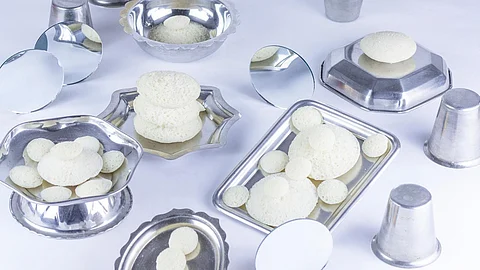
- HOMEGROWN WORLD
- #HGCREATORS
- #HGEXPLORE
- #HGVOICES
- #HGSHOP
- CAREERS
- ABOUT US
- CONTACT US

In a world of constant motion and digital immersion, there's a quiet revolution brewing — an ode to simplicity, the raw beauty of nature, and the essence of human experience. Berlin based visual artist Sarmishta Pantham embarks on this journey of rediscovery, breaking free from the shackles of analysis and logic to embrace the whimsy of intuition and creativity.
Sarmishta's imagery in her visual project 'Clouds of Heaven' is a testament to this newfound liberation. Clouds of ethereality swirl around, inviting viewers into a realm of sublime simplicity, where the mundane is transformed into the extraordinary. At the heart of this project lies an unlikely muse — the humble idli, a South Indian delicacy known for its unassuming appearance yet profound cultural significance. The image shows idlis of various shapes and sizes delicately arranged on steel utensils surrounded by filter coffee cups — a familiar sight in South Indian households. These simple elements placed together evoke nostalgia and warmth reminiscent of the daily rituals and traditions ingrained in the culture. Through her lens, the idli becomes more than just a culinary delight; it becomes a canvas for exploration, a metaphor for the human experience of transformation and self-discovery.
Have them simply, to feel simple. Have them colored in chutney, to feel colorful. Or have them doused in golden sambar, to feel doused in flavour
Sarmishta Pantham
After years entrenched in the tech world, Sarmishta found herself craving the joy of creation without boundaries. The process behind this shoot was as dynamic as the project itself. "Currently, my creative process is in an experimental mode," she explains. "I'm allowing intuition to guide me through design decisions without being too concerned about my medium." Sarmishta finds inspiration in unexpected places, drawing from nature's untamed beauty and the ingenuity of everyday life, like the resourceful techniques employed by Indian kirana store owners. However, her biggest inspiration comes from people – their stories, passions, and artistic journeys.
She admits that orchestrating the shoot was challenging, particularly when photographing food, a transient subject. Yet, she successfully captured the essence of her concept through a study of colour and transformation. But beyond the visuals lies a deeper narrative. She invites us to contemplate the relationship between food and identity, suggesting that we are not only shaped by what we eat but also by how we perceive and experience it.
We may be what we eat – but we also eat so we may become.
Sarmishta Pantham
While Sarmishta doesn't have a specific dream project in mind, she admires the work of various artists, including Julia Sarda, Naveli Choyal, and Lakwena. Their ability to create unique worlds and deliver powerful messages resonates with her. She credits her artistic father as her biggest influence—his lifelong dedication to various art forms instilled in her a deep appreciation for creativity. In addition to her father's influence, Sarmishta's multicultural upbringing, shaped by multiple relocations throughout her childhood, continues to colour her work in subtle yet profound ways. As for the future, Pantham's artistic journey continues to evolve, guided by curiosity and a thirst for exploration. With each project, she seeks to challenge conventions, spark dialogue, and uncover the beauty in the seemingly ordinary.
In Sarmishta Pantham's world, even the simplest things — like a steaming plate of idlis— hold the promise of infinite possibility. Through her lens, we are reminded that true artistry lies not in grand gestures but in the ability to see the extraordinary in the everyday.
You can follow her here.
If you enjoyed reading this, here's more from Homegrown:
A Homegrown Guide To Offline Mumbai Thrift Stores
An Indrajit Khambe Photoseries Is A Visual Love Letter To Sindhudurga's Fishing Villages
Homegrown Label Dookdi Draws On The Symmetry Of Insects To Craft Wearable Art
